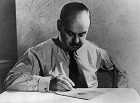Kozma Lajos
1884 - 1948

Kozma, Lajos
Kozma was one of the most prominent architects, interior, furniture and object designers and graphic artists of his time.
He graduated as an architect in 1906. After finishing his studies he joined Fiatalok Társasága (Young Ones), a group of designers who studied Hungarian folk art, architecture and designed furnitures. He was deeply influenced by folk architecture, which he wanted to incorporate into his works. This ambition of his was applied in practice by his colleague Károly Kós. The folk influences are apparent in his early works in architecture and graphic design.
He illustrated numerous publications, mainly books of poetry; his decorative ornamental style was inspired by folk architecture. These works are outstanding examples of Hungarian Art Nouveau. He became a member of the Kéve (Sheaf) group in 1911, and participated with his graphic works in their exhibitions.
He developed close ties with the famous Kner printing house in Gyoma, where he contributed Art Nouveau covers, illustrations and other book ornaments to their high standard publications. His early posters demonstrate his initial, delicate style.
Kozma worked as an architect in the studio of Béla Lajta between 1910 and 1913. This is where he started working on interior construction and furniture design projects. His furniture, object and interior designs were very influential and brought success to him. He was a prolific designer, and his works of the 1920s are outstanding elements of Art Deco interior design of the era. Most of his works represent a very typical Hungarian version of Art Deco: his style derives from Art Nouveau, folk art and earlier art tendencies, like baroque, presented in a modern, Art Deco manner.
He also designed Art Deco posters in the 1920s which are very decorative, ornamented and harmonic.
After the fall of the Hungarian Soviet Republic in 1919 his job as a teacher was terminated due to his membership of Művészeti Direktórium (Directorate of Art) during the short-lived soviet state.
He only got it back in 1947, which were the years of the ephemeral democracy after World War II. During the 1930s, he gradually turned to architecture, and designed many buildings. Among these we find condominiums, family houses, summer houses and experimental fair pavilions. His architectural style was defined by modernism. Kozma became one of the most prominent representatives of Hungarian Bauhaus architecture. His graphic design works in the 1930s show a similar tendency, his works were shifting from Art Deco towards Constructivism. He remained active until his death in 1948. .

